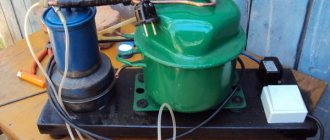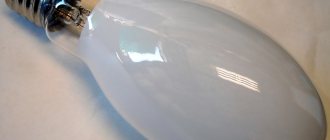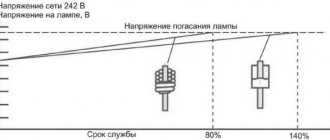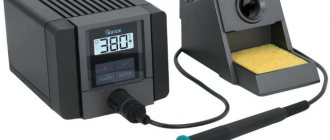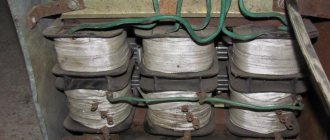Welcome to another article! It will talk about the design of a blowtorch, what it is used for and how to use it. This device can operate on various fuels, but the gasoline version is most widespread, so we will talk most about this device.
When a blowtorch works, an elongated torch with a fairly high temperature comes out of its nozzle - up to 1000 degrees. At the same time, the thermal power for different models ranges from 0.5 to 3 kW.
The fuel is poured into a special tank, which can have different volumes, again depending on the model - from 100 ml to 2 liters.
To change the power, there is a valve designed for this purpose that regulates the fuel supply.
How does a blowtorch work?
There are two main elements in the design of a blowtorch - a tank and a burner, which is also called an ejector.
The ejector is made in such a form that during operation, air moves along with the burning fuel from one end to the other. This is achieved by creating thermal draft.
The tank has a pressure pump in its body. Thanks to it, pressure is created inside the tank, which pushes the fuel poured into it out into the burner. To ensure that the pressure does not go anywhere, and that the fuel does not leak out, the neck of the tank is closed with a lid with a seal.
In addition to the above elements, the blowtorch also has other parts:
- handle for holding the lamp during operation;
- evaporator;
- a tube supplying gasoline to the evaporator;
- nozzle;
- cup for fuel to heat the burner.
For a blowtorch, just like for a car, you need high-quality gasoline. Therefore, buy it at trusted gas stations. The octane number is better to be higher - from 92. If the fuel is of poor quality, this can lead to clogging of the injector - you will have to clean it later.
Cleaning the jet
The jet, as already mentioned above, can either become clogged with dirt from low-quality fuel, or carbon deposits from its combustion. In both cases, cleaning can correct the situation. If you need to use the lamp very urgently, you can try to clean the nozzle with a needle held in pliers. But in this case, contaminants will get inside. Immediately after completing the work, it is necessary to disassemble and clean the entire blowtorch.
If there is no hurry, it is better to unscrew the jet from the burner and try to blow it with compressed air from a compressor or from a special can. Only if this method does not produce results, you can carefully use mechanical cleaning during repairs.
After cleaning the nozzle, it must be washed in gasoline and dried before installing it in the burner.
Main technical indicators of blowtorches
To choose the right blowtorch, you need to know what technical characteristics to pay attention to. The important points here will be:
- fuel tank volume
- the maximum amount of fuel that can be filled into the tank
- maximum tank pressure
- tank dimensions
- fuel consumption
- total weight of the device
- warranty and service life
To be able to work longer on one gas station, it is better to purchase a blowtorch with a large tank - 2 liters. The only exception is the case when small dimensions of the lamp are required if it is necessary to work in a limited space. Then the tank will be small.
Given that the tank has a certain volume, the amount of fuel poured into it will be less than this volume by about a quarter. This is due to the need to leave space for compressed air, which will squeeze out the fuel.
The pressure in the tank should not exceed 0.3 MPa (3 atm.). And fuel consumption depends on the maximum thermal power, but is usually 1-1.2 l/hour.
The weight of these devices does not exceed 2 kg without fuel. If you fill with gasoline, the weight will be about 3 kg for models with a 2-liter tank.
The warranty is usually given for one year, and the total service life is stated at 5 years. But you shouldn’t get too hung up on the last parameter - in fact, blowtorches last much longer in household use.
How does a blowtorch work?
The filled fuel is supplied to the burner by opening the appropriate tap. The movement of gasoline is ensured by the pressure created in advance in the tank using a pump. Gasoline is supplied to the burner in the form of gas. In order to produce exactly gas, and not drops of gasoline, the burner must be preheated. To do this, there is a special cup under it, into which the same gasoline or alcohol is poured, which, of course, must be set on fire. After burning the full volume of gasoline or alcohol that fits in this cup, the burner warms up to the desired temperature - now you can supply fuel to it and ignite it.
The gaseous state is achieved by an evaporator located in the burner. When it is heated, the fuel entering it evaporates and is then fed into the combustion chamber through a nozzle. The combustion process is maintained by drawing air through the back of the burner through the thermal draft that occurs due to the combustion of fuel.
Under no circumstances should the supply valve be opened during the burner heating procedure. Only after complete heating can it be opened. After igniting the fuel, the same tap can be used to adjust the flame power. To stop working, you just need to close the tap.
Where is a blowtorch used?
Blowtorches today are no longer as popular as, for example, 10-15 years ago. It’s just that now there are other heating devices, the same industrial hair dryers. But sometimes it happens that it is not possible to use modern technology, so they resort to blowtorches. Here are the areas in which, for example, this device can be used:
- as a warm-up for an electric soldering iron, if there is no electricity, you can heat its tip or solder;
- for welding and melting metal products with a melting point of less than 1000 degrees;
- for removing varnish on metal products
- for defrosting water in frozen metal pipes
- to warm up the car engine
- for singeing the wool of slaughtered cattle
This list is not exhaustive - a blowtorch can also be used for other purposes where high temperatures are needed.
Application [ edit | edit code ]
The blowtorch is used for:
- heating parts and melting solder during soldering,
- welding of some materials at temperatures up to 1000–1100 °C,
- soldering iron heating,
- heating varnish and paint coatings to remove them,
- warming frozen water pipes,
- tarring pork carcasses (burning out bristles),
- disinfection and disinsection of premises,
- cooking in camp conditions (with certain devices - in particular, a specially curved pipe),
- dismantling rusted connections of steel and cast iron pipes.
How to use a blowtorch?
Here are some instructions on how to use a blowtorch.
It is advisable to operate this lamp only outdoors. Although its use for short-term work in enclosed spaces is allowed, it is still better not to do this. If this cannot be avoided, then you need to protect yourself from possible troubles in advance: you need to ensure good ventilation, place a metal tray under the place where you work with the lamp in case of fuel leakage, and of course place a fire extinguisher nearby.
To start the lamp you need to do the following:
- fill the tank with fuel to 3/4 of its volume
- make about 10 quick movements with the injection pump to create pressure in the tank
- pour gasoline or alcohol into a cup to heat the burner and set it on fire, ensuring that there are no drafts during the combustion process
- After burning gasoline or alcohol in the cup, you need to slowly open the tap to supply fuel in a gaseous state. If the fuel comes out in the form of droplets rather than gas, it is necessary to repeat the burner preheating process
- Having reached the gaseous stream of fuel, it is necessary to ignite it and wait a little until the burner heats up even more
- The flame must be adjusted by rotating the tap
- if the flame is unstable or goes out, it means the nozzle is clogged - it must be cleaned for further operation
- To complete the work you need to close the tap. After the lamp has cooled down, bleed the air from the tank.
The most common malfunctions and causes of failure
The most common malfunctions of a blowtorch are as follows:
- the pressure required for normal operation is absent or rapidly decreasing in the housing;
- there is no flame due to the fact that the fuel stream from the injector does not meet the required parameters;
- fuel leaks through joints and seals;
- Instead of spraying, a stream flows out of the nozzle.
Some problems can be fixed if you have the necessary tools at hand. Typically, repair work consists of cleaning individual components.
Sometimes the breakdown is so serious that it is impossible to repair the tool without the spare parts used for the blowtorch. Fortunately, you can find many repair kits in hardware stores and on specialized websites on the Internet.
The reason for the lack of pressure in the lamp may be a faulty pump. It can be replaced or repaired with your own hands. A rapid decrease in pressure occurs if the threaded connections, service and safety valves are leaking.
The problem is solved by replacing the gaskets, cleaning the surfaces of the covers and valves in contact with the body.
There is no burner flame if the fuel stream coming from the nozzle is very weak or intermittent. This can occur due to contaminants that have entered the lamp with low-quality fuel. In this case, it is necessary to clean all the channels and the jet with suitable tools and rinse the lamp with clean gasoline.
Fuel leaks through the seals of the control valve if the stuffing box, which is the sealing gasket between the body and the valve, has lost its properties. Repairing the malfunction involves disassembling the tap and replacing the stuffing box.
If fuel streams out of the burner, the reason is most likely that the nozzle opening is not correct. Before this, you need to make sure that the instrument is really warmed up. If problems of this kind recur during warm-up, the burner nozzle must be replaced.
Rules for the safe use of a blowtorch
Any tool requires compliance with safety precautions, and this applies primarily to a blowtorch, since it uses a highly flammable product - gasoline. Careless use may result in a fire or even an explosion. Therefore, the following rules should be observed:
- Do not use a device that has a fuel leak
- Do not use unsuitable fuel that does not meet the manufacturer’s requirements
- You cannot use the lamp continuously for a long time, since during operation the fuel tank gradually heats up.
- Do not use a blowtorch that has a faulty safety valve.
- Do not open the tank while the burner is burning, or until it cools completely after stopping operation.
- If there is no urgent need, refrain from using a blowtorch indoors
By following these rules, you will protect yourself and others as much as possible from unpleasant consequences.
So, in this article we looked at such a device as a blowtorch. Now, knowing the information on the design and operation of this unit, you can decide for yourself whether you need it, which one to choose, if you still need it, and how to operate it so as not to harm yourself and others.
Source instrument-tehnika.ru
A blowtorch, as a device for performing a variety of repair and construction work, is still in wide demand. Their popularity is due to their compactness, ease of use, and, subject to proper operation, also safety. We will discuss below how to work with the lamp correctly and maintain it on time.
Device
A gasoline blowtorch consists of the following components:
- A burner designed to use a specific type of fuel. For example, a gas blowtorch will have a different burner design than a device using liquid fuel.
- Fuel tank.
- Systems for supplying the combustible mixture to the burner.
- Manual fuel supercharger (pump).
- Shut-off and control device.
- Check valve (not available in all designs).
- Holding handle.
To achieve compactness, the booster pump is located directly in the tank. Before use, the user should pump the pump several times to create the required vacuum level: then the fuel will flow to the regulator.
The fuel supply system is extremely simple, and works on the principle of a locking needle: when such a needle moves in the cross section of the regulator, the pressure of the mixture changes, which determines a certain rate of fuel supply to the burner. Such pumping should be done periodically, as the external characteristics of the flame change. On the contrary, if work with the blowtorch is completed, then the pressure must be released. In modern devices, a check valve is used for this purpose; in lamps of an older design, the tank lid is simply opened slightly.
Some types of blowtorches are equipped with a remote burner, which is equipped with a long hose. In this case, an ordinary bulb made of gasoline and oil resistant rubber is used as a supercharger. A nipple inlet is used to connect the hose to the bulb and the tank body.
There is a valve on the end surface of the regulator, by opening which you can ensure the supply of gasoline mixture to the fuel-burning device. Under the pressure of the mixture, the regulator needle moves and opens access to the burner working space. From there the mixture enters the nozzle, is dispersed and ignited.
Special products for copper tips
To remove carbon deposits, the industry produces a variety of products; extensive practical experience has been accumulated, which is used in modern tip preparation technologies. Approaches to cleaning differ, although, in principle, they come down to two main options for influencing fumes: mechanical and chemical.
Mechanical types of cleaning
Depending on the type of work to be done, you can choose one or another abrasive material. If there is a need to make the tip strictly even and flat, you should take a file. In other cases you can use:
- sandpaper;
- sharpening stones;
- abrasive sponges.
To remove the patina from a new soldering iron, use fine-grit sandpaper. This will be enough to remove a thin production layer. After mechanical cleaning is completed, the tip is treated with rosin or other suitable resin. The rosin composition does a good job of removing plaque consisting of oxides and other impurities.
If desired and possible, you can buy a ready-made device wts-599b. This metal sponge in a special housing is very convenient to use.
Chemical methods
There are possibilities for cleaning the tip with chemical means. You need to choose flux cleaners carefully, after first familiarizing yourself with the metal composition of the tip.
How to use a blowtorch?
The safety of a gasoline blowtorch is also ensured by the fact that it is difficult to ignite the mixture directly in the burner, since the volatility of gasoline at ordinary room temperature is insufficient for ignition. Therefore, after checking the functionality of the device, the llama is pre-ignited. To do this, pour a little gasoline into a special cup and place it under the burner. The gasoline is set on fire, and when the flame begins to die out, the fuel supply valve is opened. Under the influence of internal pressure, the mixture leaves the nozzle nozzle, enters the zone of heated air containing gasoline vapor, heats up and spontaneously ignites. Then, using the control valve, the degree of extension of the needle in the burner is changed, which regulates the length and intensity of the torch.
The volatility and low density of gasoline provide sufficient conditions for its self-mixing. However, it is impossible to completely fill the tank with gasoline: it is necessary to ensure excess pressure of gasoline, which will be sufficient for its stable flow to the control device. In some designs, designed for lower values of excess pressure, not only a guide tube, but also a wick is provided for transporting gasoline.
The booster pump moves in rubber seals. To prevent them from becoming unusable ahead of time, the movements of the handle should not be sharp.
The duration of reliable operation of a blowtorch also depends on the type of mixture used to heat the lamp. For example, gasoline, even high-octane gasoline, contains organic compounds that, when burned, produce carbon deposits on the surface of the burner. Therefore, experts advise using ethyl alcohol for this purpose.
Lighting a gasoline blowtorch must be done outdoors, but without wind or drafts. If, after pumping and opening the tap, a vaporous mixture comes out of the nozzle, then its parameters are sufficient for ignition with a regular match or lighter. On the contrary, if liquid comes from the nozzle, then dispersing the mixture is not enough, and preheating it is required.
Handling old lamps
Old blowtorches that have not been used for a long time should first be inspected from the outside. During inspection, you need to check how easily all the valves and the tank lid open. The adjustment valve should turn easily.
After this, you need to check the housing for leaks. To do this, use a pump to pump air into a lamp that is not filled with fuel. Then, using a brush, apply a thick soap solution to all threaded connections and the faucet. You need to check it closed and open.
If all connections are tight and the pump is properly creating pressure in the housing, the tap performs its functions by opening and closing the burner, the lamp can be refilled and started.
A mandatory tool, without which it is impossible to do soldering, is a soldering iron. There are several types of it. In an electric soldering iron, the most popular tool among craftsmen, a heating element heats up a copper tip.
In other models, the working area is heated by a stream of heated air or an open flame. Thirdly, the tip has a massive appearance, reminiscent of a hammer in shape, the heating of which is provided by electricity. There are hammer soldering irons with the ability to heat the tip over an open fire.
Repair and performance check
If a gasoline blowtorch has not been used for a long time, then it is necessary to determine its suitability for work. To assess the quality of the device, perform the following steps:
- After igniting the torch, the degree of heating of the outer surface of the tank is set: if heating occurs evenly and gradually, then the parameters of the torch are stabilized, and the hum of the fire becomes uniform. The tank, however, should not be heated to temperatures exceeding 50 ° C.
- The nozzle tip is placed at a distance of 20...30 mm from the steel sheet: with a normal operating lamp, heating will be uniform, and as its duration increases, the flame will stabilize, which is explained by the reflection of the heat flow from the steel surface. If at the same time the flame disappears from time to time or goes out immediately, then the lamp cannot be used.
- Check the operation of the check valve: when the device is turned off, the mixture above the surface of the gasoline in the tank should bleed spontaneously.
- Check the operating pressure limits inside the tank with a pressure gauge. During normal operation of the lamp, these pressures should not exceed 0.3 MPa. Sudden fluctuations are a consequence of a malfunction in the fuel supply system to the regulator.
Maintenance and repair of gasoline-powered blowtorches are carried out to ensure an uninterrupted and uniform supply of fuel and the required degree of dispersion. Most often, the hole in the nozzle becomes clogged, so the set of accessories for the blowtorch includes a special needle with a diameter of no more than 0.5 mm.
Pump repair
The blowtorch pump consists of a piston enclosed in a metal housing and a spool, which is installed at the end of the piston tube and operates on the principle of a check valve. It lets air into the body and does not let it back out.
At the end of the piston there is a leather cuff that pushes air when moving inside the lamp, and folds up to let air through when moving in the opposite direction.
This piece is simply a circle of leather sandwiched between two steel washers of different diameters. The upper washer is almost equal in diameter to the diameter of the cylinder, and the lower one is several millimeters smaller. Thanks to this, the cuff is able to pump air, folding only in one direction when necessary. To increase the service life of the cuff from repair to repair, it must be lubricated occasionally with thick lubricant.
Most often, the spool or cuff is faulty. Repairing a blowtorch pump will involve replacing them with serviceable ones. The best option for repairs would be to take working spare parts from a non-working old blowtorch, if possible. If you cannot find them, you will have to buy these parts.
The cuff, however, can be cut from a suitable piece of leather or from any suitable cuff for another pump.
What is the frequency of checking blowtorches?
A blowtorch is a source of increased danger, therefore, for its operation, adhere to the following rules:
- Do not use low-octane gasoline.
- Do not operate the device in the presence of leaks and a sharp increase in the temperature of the tank, as well as in an unsatisfactorily ventilated area.
- Do not refill the lamp during its operation or immediately after use.
- The lamp is inspected periodically.
The maintenance frequency is set as follows:
- In order to fully check hydraulic gasoline supply systems - at least once a year.
- In order to check the tightness and tightness of connections - at least once a month.
- To check the stability of the torch - each time before the next use, when the lamp body has completely cooled down.
The price of gasoline blowtorches is determined by their configuration, the developed thermal power and the volume of the fuel tank. It fluctuates in the range of 800... 1000 rubles.
Source proinstrumentinfo.ru
Characteristics in the rating
| 1 | Motor Sich LP-2M | The most reliable |
| 2 | Bison Expert SAMOTLOR SM-15, with cast iron ejector | The most popular |
| 3 | Bars 91452 | Better heating, stable flame |
| 4 | SIBRTECH 91442 | Best value for money |
| 1 | DREMEL Versaflame 2200-4 | Best functionality |
| 2 | Kemper 1060 KIT | The most convenient |
Blowtorches, unlike soldering irons, are not designed for delicate work with instruments and electronics. These are powerful, energy-independent devices - heating is created by the combustion of liquid fuel or gas. Since the heating temperature in many models exceeds 1000˚C, a blowtorch can melt materials of increased hardness.
Before purchasing, you need to know exactly for what purpose the equipment is being purchased. There are a lot of offers in stores - on gasoline, on gas. Gasoline gives a higher temperature, but is quickly consumed, so liquid fuel burners are equipped with capacious and rather heavy fuel cylinders. Gas blowtorches are much lighter.
If you need a budget option, you can take a closer look at domestic brands. Many of them are not inferior to imported brands. For example, for “amateur” work, an inexpensive but good gasoline “Bison” is quite suitable. If you have a lot of work to do and require the power and increased functionality of a blowtorch, it is better to opt for a more powerful device like the Dremel Versaflame, which runs on gas. It will cost many times more, but it will be completely worth the money spent.
Cleaning the fireproof tip
Purchasing soldering irons with a non-burning tip is a great joy, which can quickly become dark during intensive work. After some time, a black coating appears on the surface of the heating end, and soldering goes worse and worse. It becomes obvious that you need to clean your soldering tool.
Iron scourers are not suitable for delicate materials. They may scratch the surface. As a last resort, a washcloth made of copper or bronze threads will do.
A good, inexpensive product is a cellulose sponge. It is often included in professional cleaning kits. Please note that the product must have an inscription confirming the cellulose composition. It is not always possible to determine the quality of a soldering iron sponge externally; other threads and impurities can oxidize and aggravate the situation.
An alternative option is a viscose sponge. In practical use for cleaning the tip, it does not differ in properties from natural cellulose material. The sponge can be moistened not only with water, but also with glycerin. In extreme cases, a piece of cloth will do just fine instead of a sponge.
The soldering iron needs to be heated and cleaned with wet material; dry material will not help. Carbon deposits are removed with simple movements, as if you were wiping the rod. Sometimes craftsmen cut a depression in the sponge, which makes cleaning the tip even easier.
2 Bison Expert SAMOTLOR SM-15, with cast iron ejector
The gasoline blowtorch from the domestic brand “Zubr” is especially popular. Users are attracted by the low price and good quality. Many people buy it because it is a trusted manufacturer of various high-quality tools and equipment. It is relatively small in size, but one refill is enough for an hour of work. Volume – 1.5 liters. Important advantages are a cast iron ejector and the presence of a protective casing that prevents the flame from blowing out when working outside in windy weather. At the bottom of the handle there is a compartment for a repair kit, closed with a stopper - this is also convenient.
The lamp can run on 92 or 95 unleaded gasoline. The design is simple, safe and reliable. Reviews vary, but more often users note a good heating speed, low weight even when filled, and the presence of a repair kit. The downside is that the nozzle often gets clogged and you have to clean it with a needle between jobs.


